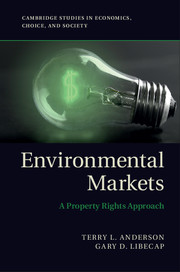Book contents
- Frontmatter
- Contents
- List of Figures and Tables
- Preface
- Acknowledgments
- 1 Who Owns the Environment?
- 2 Is Government Regulation the Solution?
- 3 Property Rights for the Common Pool
- 4 Local Property Rights to the Commons
- 5 The Politics of Property Rights
- 6 From Property Rights to Markets
- 7 Tackling the Global Commons
- 8 Property Rights and Environmental Markets
- Index
- References
4 - Local Property Rights to the Commons
Published online by Cambridge University Press: 05 July 2014
- Frontmatter
- Contents
- List of Figures and Tables
- Preface
- Acknowledgments
- 1 Who Owns the Environment?
- 2 Is Government Regulation the Solution?
- 3 Property Rights for the Common Pool
- 4 Local Property Rights to the Commons
- 5 The Politics of Property Rights
- 6 From Property Rights to Markets
- 7 Tackling the Global Commons
- 8 Property Rights and Environmental Markets
- Index
- References
Summary
We have emphasized the losses of open access attributable to individual efforts to capture resource rents in the absence of property rights. Although it is rational for individuals to ignore their effect on the overall value of an open-access resource, it can also make sense for individuals to act collectively to constrain their actions to protect and increase rents. The common solution proposed by economists is either private property rights that limit access or governmental regulation.
Another solution that has received more recent attention is a blend of informal property rights and local collective action known as common property resource management or CPRM. Common property resource management limits entry to individuals who are members of the group and excludes outsiders. CPRM generally works best if there are internal governance structures to link individual actions with group goals and if the state recognizes and enforces common property resource organizations and boundaries. Examples of CPRM include local grazing associations, fishing cooperatives, mutual irrigation companies, and groundwater management cooperatives. Common property can reduce over-exploitation relative to open access, but competitive incentives remain within the group to varying degrees, depending on institutional design and group cohesion. Accordingly, it may still be less efficient than sole ownership or, in some cases, than regulation.
As with environmental markets based on private property rights, CPRM can allow trade, but it is more often informal, usually among group members and sometimes involving the approval of community leaders. Casual water exchanges among farmers within irrigation districts in the western U.S. are an example of common property trade. Farmers within irrigation districts often do not have clearly-defined individual rights to water when the district holds the water rights. However, they have customary use claims that allow an irrigator to acquire additional water during a growing season from other irrigators on an informal basis.
- Type
- Chapter
- Information
- Environmental MarketsA Property Rights Approach, pp. 92 - 112Publisher: Cambridge University PressPrint publication year: 2014



